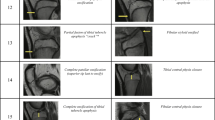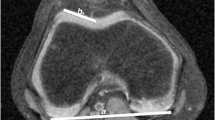Abstract
Background
The osseous morphology of the patellofemoral joint is an independent factor that affects the biomechanics of patellofemoral instability.
Objective
The purpose of this study is to determine age- and gender-related differences in the osseous morphology of the patellofemoral joint in children during skeletal maturation.
Materials and methods
This study was approved by the institutional review board and was HIPAA-compliant. We included 97 children and young adults (age range 5–22 years; 51 girls and 46 boys, mean ages 14.3 years and 13.7 years, respectively). We studied 1.5-T knee MR exams, measuring the osseous morphology of the patellofemoral joint (lateral trochlear inclination, trochlear facet asymmetry, trochlear depth, patellar height ratio, tibial tubercle-trochlear groove distance, and lateral patellofemoral angle) for each MR exam. We compared measurements to published values for patellofemoral instability. Physeal patency (open or closing/closed) was determined on MR. We assessed the associations between MR osseous measurements and gender, age and physeal patency using Wilcoxon rank sum test and least square means regression models.
Results
The osseous patellofemoral joint morphology measurements were all within a normal range. There were no significant correlations between MR osseous measurements and age, gender or physeal patency.
Conclusion
During skeletal maturation, age and gender do not affect the osseous morphology or congruency of the patellofemoral joint.






Similar content being viewed by others
References
Buckwalter JSA, Rosenberg LL, Hunzicker EB (1990) Articular cartilage composition, structure, response to injury, and methods of facilitating repair. In: Ewing JW (ed) Articular cartilage and knee joint function: basic science and arthroscopy. Raven, New York, pp 19–56
Meachim G, Bentley G, Baker R (1977) Effect of age on thickness of adult patellar articular cartilage. Ann Rheum Dis 36:563–568
Buckwalter JA, Roughley PJ, Rosenberg LC (1994) Age-related changes in cartilage proteoglycans: quantitative electron microscopic studies. Microsc Res Tech 28:398–408
Stockwell RA (1971) The interrelationship of cell density and cartilage thickness in mammalian articular cartilage. J Anat 109:411–421
Stoller DW, Li AE, Anderson LJ et al (2007) Magnetic resonance imaging in orthopaedics and sports medicine, 3rd edn. Lippincott Williams & Wilkins, Philadelphia, pp 577–616
Escala JS, Mellado JM, Olona M et al (2006) Objective patellar instability: MR-based quantitative assessment of potentially associated anatomical features. Knee Surg Sports Traumatol Arthrosc 14:264–272
Miller TT, Staron RB, Feldman F (1996) Patellar height on sagittal MR imaging of the knee. AJR Am J Roentgenol 167:339–341
Pfirrmann CW, Zanetti M, Romero J et al (2000) Femoral trochlear dysplasia: MR findings. Radiology 216:858–864
Toms AP, Cahir J, Swift L et al (2009) Imaging the femoral sulcus with ultrasound, CT, and MRI: reliability and generalizability in patients with patellar instability. Skeletal Radiol 38:329–338
Nietosvaara Y, Aalto K, Kallio PE (1994) Acute patellar dislocation in children: incidence and associated osteochondral fractures. J Pediatr Orthop 14:513–515
Fithian DC, Paxton EW, Stone ML et al (2004) Epidemiology and natural history of acute patellar dislocation. Am J Sports Med 32:1114–1121
Duchman K, Mellecker C, Thedens DR et al (2011) Quantifying the effects of extensor mechanism medializatlon procedures using MRI: a cadaver-based study. Iowa Orthop J 31:90–98
Kim HK, Laor T, Shire NJ et al (2008) Anterior and posterior cruciate ligaments at different patient ages: MR imaging findings. Radiology 247:826–835
Ogden JA (1984) Radiology of postnatal skeletal development. X. Patella and tibial tuberosity. Skeletal Radiol 11:246–257
Carrillon Y, Abidi H, Dejour D et al (2000) Patellar instability: assessment on MR images by measuring the lateral trochlear inclination-initial experience. Radiology 216:582–585
Dejour H, Walch G, Nove-Josserand L et al (1994) Factors of patellar instability: an anatomic radiographic study. Knee Surg Sports Traumatol Arthrosc 2:19–26
Laurin CA, Levesque HP, Dussault R et al (1978) The abnormal lateral patellofemoral angle: a diagnostic roentgenographic sign of recurrent patellar subluxation. J Bone Joint Surg Am 60:55–60
Diederichs G, Issever AS, Scheffler S (2010) MR imaging of patellar instability: injury patterns and assessment of risk factors. Radiographics 30:961–981
Balcarek P, Jung K, Frosch KH et al (2011) Value of the tibial tuberosity-trochlear groove distance in patellar instability in the young athlete. Am J Sports Med 39:1756–1761
Lustig S, Servien E, Ait Si Selmi T et al (2006) Factors affecting reliability of TT-TG measurements before and after medialization: a CT-scan study. Rev Chir Orthop Reparatrice Appar Mot 92:429–436
Saudan M, Fritschy D (2000) AT-TG (anterior tuberosity-trochlear groove): interobserver variability in CT measurements in subjects with patellar instability. Rev Chir Orthop Reparatrice Appar Mot 86:250–255
Alemparte J, Ekdahl M, Burnier L et al (2007) Patellofemoral evaluation with radiographs and computed tomography scans in 60 knees of asymptomatic subjects. Arthroscopy 23:170–177
Conflicts of interest
None
Author information
Authors and Affiliations
Corresponding author
Rights and permissions
About this article
Cite this article
Kim, H.K., Shiraj, S., Anton, C. et al. The patellofemoral joint: do age and gender affect skeletal maturation of the osseous morphology in children?. Pediatr Radiol 44, 141–148 (2014). https://doi.org/10.1007/s00247-013-2790-2
Received:
Revised:
Accepted:
Published:
Issue Date:
DOI: https://doi.org/10.1007/s00247-013-2790-2




